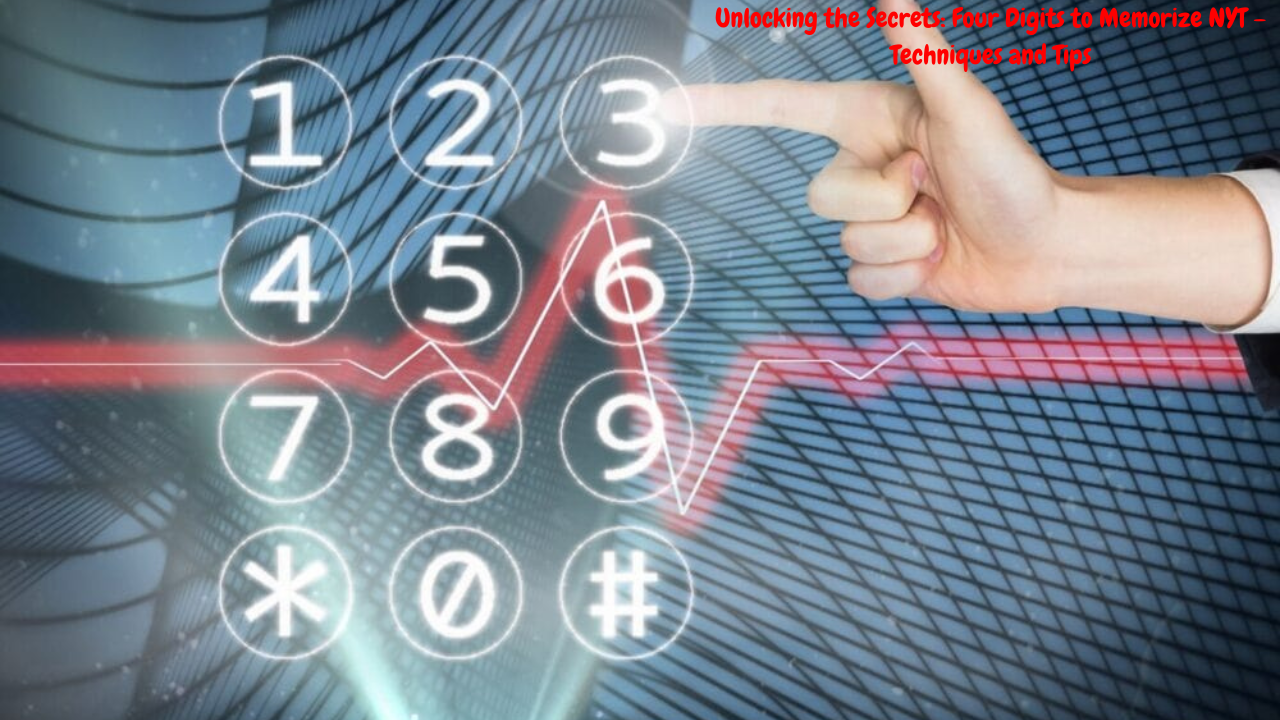Four Digits to Memorize NYT! In our speedy- paced world, figures play a important function in our each day lives. From telephone figures and Legs to vital dates and regard word, we are continuously bombarded with numerical information. Among these, 4- number figures regularly stand out as particularly challenging to bear in mind due to their brief yet complexnature.
However, you ’re no longer by myself, If you ’ve ever determined your tone floundering to flash back a named set of 4 integers. In this comprehensive blog post, we ’ll explore different strategies to study four- number figures, in particular knitter- made for compendiums of The New York Times( NYT) – your last primer to learning this pivotal skill. Four Digits to Memorize NYT!
Four Digits to Memorize NYT!
Why study Four- number figures?
Before diving into the strategies, it’s important to fete why learning 4- number figures can be particularly useful. Then are a many motives:
- Security: Four- number Legs and watchwords are generally used for banking, online bills, and security structures. Flashing back those figures ensures your accounts are steady and without difficulty on hand.
- Convenience: Flashing back critical figures like the ending 4 integers of a social safety number, credit card volume, or phone volume can save time and drop frustration.
- Mental Agility: The process of learning figures can ameliorate your universal reminiscence capabilities and cognitive function, keeping your mind sharp. ways to study Four- number figures.
1. Chunking
Chunking entails breaking down a bigger piece of information into lower, implicit corridor. This system leverages our brain’s desire for patterns and lower sets of data.
Example:
- Number: 2763
- Chunked: 27 and 63
By dividing the volume into lower figures, it’ll come less delicate to bear in mind.
2. Visualization
Creating a intellectual snap related to the figures can specially prop in memory retention. imaging some thing familiar or placing could make the figures lesser memorable.
Example:
- Number: 2763
- Fantasize: 27 as a brace of bones showing 2 and 7, and 63 as a withdrawal age with an snap of a gold watch. Visualization hyperlinks abstract figures to concrete snaps, making them less delicate to don’t forget.
3. Association
Linking figures to informed ideas or tremendous particular gests could make them more memorable. This approach gates into your being moxie base and emotional connections.
Example:
- Number: 2763
- Associate: 27 along with your twenty seventh birthday and sixty three along with your forefather’s withdrawal age.
By associating figures with meaningful events or mortal beings, they come less delicate to don’t forget.
4. Mnemonics
Mnemonics involve growing a expression or word where each element represents a number in the volume. This system is especially effective for learning sequences of figures.
Example:
- Number: 2763
- Mnemonic: ” Two Giant Snakes Three “
Creating a quirky or memorable expression enables anchor the integers for your reminiscence.
5. Repetition
Repetition is a classic system that enhances memory through harmonious practice. constantly writing down or articulating the range enables solidify it for your studies.
Example:
- Number: 2763
- Practice: Write down 2763 a couple of times and say it out loud constantly.
Reiteration enables switch information from brief- term to lengthy- time period reminiscence.
6. Proses and Measures
Using rhymes and measures can make the figures stick. Creating a jingle or a track with the variety can be a entertaining and important way to study it.
Example:
- Number: 2763
- Rhyme: ” Twenty- seven, sixty- 3, it’s as smooth as can be! “
Adding a musical detail can make the memorization manner instigative and important.
7. Storytelling
This approach uses narrative to link the figures together.
Example:
- Number: 2763
- Story: ” At 27, I traveled sixty three long hauls to satisfy my friend. “
Practical Applications: Real-World Examples
-
learning Important Dates
Still, you might come upon good sized 4- number times that you want to consider, If you frequently examine papers roughly major events or anniversaries in The New York Times.
Example:
- Time: 1945( End of World War II)
- Fashion: Association
- Associate: 19( youngish dogface) and 45( peace sign).
-
Flashing: Back Subscription Details
For NYT subscribers, flashing back the last 4 integers of your subscription range may be salutary for logging in or client support inquiries.
Example:
- Number: 1234
- Fashion: Chunking and Visualization
- Knob: 12( dozen eggs) and 34( a basketball jersey number).
-
Recalling: Contact Information
Whether it’s the ending 4 integers of a intelligencer’s cellphone wide variety or a touch at NYT, flashing back these figures can be vital.
Example:
- Number: 8765
- Fashion: Mnemonics
- Mnemonic: ” Eight Unicorns, Seven Brownies “.
Advanced ways and Tools
For those trying to embellish their memory in addition, several superior strategies and tools may be integrated.
-
Memory Palaces
A reminiscence palace entails imaging a familiar region and associating each room or region with the volume you need to recollect.
Example:
- Number: 2763
- Memory Palace: Imagine your house, place 27 in the kitchen( seven- subcaste goodies), and sixty three in the living room( a big timepiece showing 630).
-
Spaced Repetition Systems( SRS)
Spaced reiteration is a studying approach that entails growing ages of time among posterior overview of formerly learned material.
Example:
- Use apps like Anki or Quizlet to record periodic opinions of the number 2763 to make sure it stays fresh on your reminiscence.
-
Flashcards
Creating flashcards with the number on one hand and the visualization, story, or mnemonic on the contrary may be a helpful device for exercise.
Example:
- Number: 2763
- Flashcard: One aspect with ” 2763 ” and the volition with ” Two Seven- subcaste galettes and a Large timepiece. “
The Cerebral Aspect of Memory
Understanding how our memory works can in addition bedeck our capacity to study 4- number figures.
-
Short- Termvs. Long- Term Memory
Short- term memory holds data compactly, while lengthy- time period memory shops information more permanently. ways like reiteration and liar help transfer statistics from short- time period to long- time period memory.
-
The part of feelings Emotional
Connections can beef up reminiscence retention. Associating figures with emotionally charged events or meaningful private gests can make them less delicate to consider.
-
Cognitive Cargo
Reducing cognitive cargo by using breaking down information into lower gobbets( chunking) or linking it to informed generalities( cooperation) makes it less complicated to procedure and don’t forget.
Common Challenges and results
-
Forgetting Due to Lack of Use
Regularly reviewing and working towards the figures you want to do not forget helps keep them sparkling to your memory.
-
Confusion with Analogous Figures
Using distinct and bright visualizations or mnemonics can help separate among similar figures.
-
Overfilling with Too important Information
Focus on learning a many figures at a time, and use spaced reiteration to regularly boom the volume of data you save.
Real- Life witnesses and Case Studies
To give a further comprehensive understanding, allow’s explore a many factual- cultures witnesses and case studies of people who have rightly used these strategies to study four- number figures.
Case Study : 1 A Student’s Journey
Jane, a council pupil, used the chunking and reiteration strategies to study ancient dates for her examinations. By associating each date with a wide event in her cultures, she changed into able of bear in mind them without problems all through examinations.
Case Study 2: A Professional’s Strategy
John, a financial critic, trusted visualization and mnemonics to flash back important purchaser account figures. His approach of creating vibrant internal snaps for every range significantly stepped forward his effectiveness at work.
Testimonial Enhancing Everyday Life
Sarah, a mama of three, located liar to be the only approach for flashing back her youths’s faculty ID figures and vital dates. Casting a brief narrative around each range made them clean to keep in mind indeed amidst her busy schedule.
Conclusion
Four Digits to Memorize NYT! learning four- number figures may also appear hard in the morning, but with the proper ways and a bit of practice, it could come a realizable and indeed instigative design. Whether you ’re a scholar, a professional, or in reality a person seeking to enhance your reminiscence capabilities, these strategies will let you keep critical numerical data painlessly.
From chunking and visualization to mnemonics and liar, there are colorful strategies you may appoint to make four- number figures stick. Incorporating advanced ways like memory palaces and spaced reiteration can also bedeck your memory retention.
Understanding the cerebral aspects of memory and addressing commonplace challenges can also useful resource to your adventure to getting to know four- number figures. By making use of those strategies in factual- transnational eventualities, you may ameliorate your protection, convenience, and cognitive dexterity.
As you exercise and upgrade these strategies, you ’ll discover that learning four- number figures turns into 2nd nature. So the posterior time you come upon a 4- number variety, whether it’s in your every day cultures or while reading The New York Times, you ’ll be equipped with the tools to do not forget it results easily.




